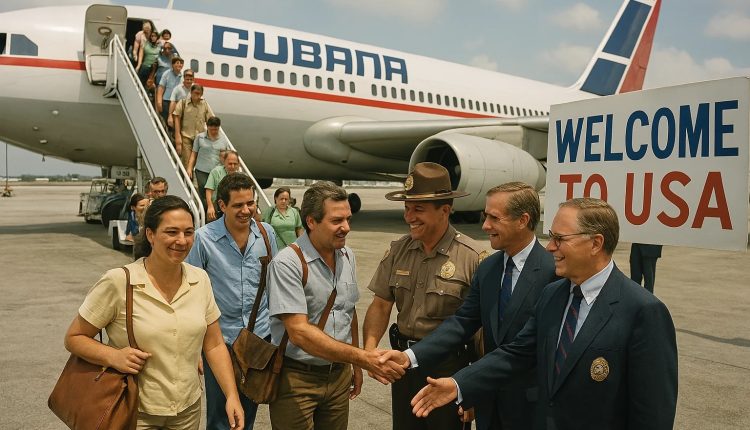
From exile to empowerment: A model for immigration
It is appropriate at a time when xenophobia runs rampant to remember that, when Fidel Castro came to power in 1959, waves of Cubans—professionals, merchants, students, the devoutly religious and the politically dispossessed—began fleeing the island in search of freedom. By the early 1960s, the United States faced one of the most significant refugee influxes in its modern history. More than a quarter of a million Cubans arrived within a few years, many with little more than their education, memories, and hopes for return.
But what unfolded next was not a story of drift or decline. It was the beginning of one of the most extraordinary immigrant success stories in American history—a story not only of exile, but of transformation. The success of the Cuban-American community owes much to its own resilience, but it is also inextricably tied to a vast network of government and community-based programs launched in the early 1960s, when the Cold War was heating and the United States was eager to showcase the superiority of its democratic model.
The Cuban Refugee Program (CRP), initiated under President John F. Kennedy in 1961, was a policy innovation that blended humanitarian response with Cold War strategy. Administered through the Department of Health, Education, and Welfare, the program extended a broad range of services—cash assistance, healthcare, job placement, educational support, student loans, and legal aid—to thousands of Cubans arriving almost daily. Though Miami became the symbolic and logistical heart of the exile community, the federal government intentionally dispersed refugees across dozens of American cities. From Chicago to New York, Los Angeles to Atlanta, Cuban exiles received job referrals, relocation assistance, and English-language instruction.
The CRP stood out for its emphasis on professional revalidation. In an era when foreign credentials were often viewed with suspicion, the United States created bespoke pathways for Cuban doctors, engineers, and lawyers to re-enter their professions. Universities like Columbia, Georgetown, and the University of Miami worked with federal agencies to offer refresher courses, licensing support, and accelerated degree programs. Hospitals welcomed Cuban physicians into residency-equivalent roles. Law schools crafted comparative law seminars for attorneys from Havana and Santiago de Cuba to learn American jurisprudence. These efforts paid dividends: many of these professionals went on to become anchors of the Cuban-American middle class, and later, leaders of powerful political and business networks.
Healthcare was another cornerstone of the assistance model. Refugees were granted access to public clinics, and new facilities were opened in South Florida to accommodate the growing population. Mental health support was offered—often in Spanish—acknowledging, even in those early years, the psychic wounds of exile and cultural rupture. For the elderly, special housing complexes and social services helped provide a measure of dignity in dislocation.
Children and youth were not forgotten. Cuban children were quickly absorbed into public schools, often with bilingual support and school supplies furnished through federal grants. Teenagers and young adults were offered vocational training, scholarships, and the possibility of completing disrupted university studies. One of the most poignant, although controversial initiatives, Operation Peter Pan, brought over 14,000 unaccompanied children to the United States between 1960 and 1962. Orchestrated through a secret collaboration between the Catholic Church and U.S. officials, it became a defining experience for a generation of exiled youth.
Churches and religious organizations played a leading role. Catholic Charities, Jewish relief agencies, and Protestant groups worked together with federal and state agencies to deliver aid, offer counseling, and help Cuban families adjust to their new reality. These voluntary agencies, or VOLAGs, often provided the first point of contact for Cuban refugees in unfamiliar cities, offering both material aid and cultural anchorage.
What emerged over the following decades was a remarkable trajectory. Cuban exiles became homeowners, entrepreneurs, physicians, politicians. In cities like Miami, they redefined local culture, commerce, and governance. By the 1980s, Cuban-Americans were serving in Congress, launching multinational businesses, and shaping national conversations on foreign policy and immigration.
The scale and coordination of the Cuban Refugee Program were unprecedented and remain unmatched. Subsequent waves of refugees from Mexico, Venezuela, Vietnam, Haiti, and the Middle East would receive far less generous support or none. The kindness shown toward Cubans reflected not only the humanitarian instinct, but also the political calculation of the Cold War: the exiles of communism were accepted as ideological allies, not just as victims of turmoil.
Still, the effectiveness of these programs cannot be dismissed as mere propaganda. They worked. In combination with the cultural capital brought by the exiles themselves—education, discipline, ambition—they helped lay the foundation for one of the most successful immigrant communities in the United States.
Today, as debates about asylum and immigration intensify, the Cuban exile experience offers a rare model of what is possible when government investment, community organization, and individual perseverance converge. The legacy of the 1960s programs lives on not just in archival records or nostalgic memory, but in the bustling neighborhoods of Miami, the corridors of Congress, and the enduring influence of a diaspora that turned exile into empowerment. Imagine the dividends of offering similar assistance to all immigrants instead of the disdain, abuses, and discrimination they must now endure.

